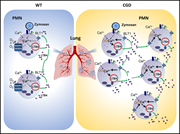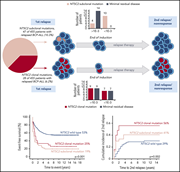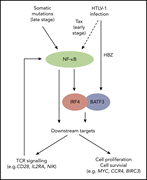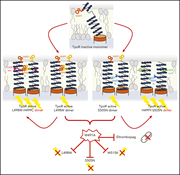Issue Archive
Table of Contents
BLOOD COMMENTARIES
PLENARY PAPER
NADPH oxidase controls pulmonary neutrophil infiltration in the response to fungal cell walls by limiting LTB4
Chronic granulomatous disease (CGD), caused by inactivating mutations in the NAD phosphate (NADPH) oxidase complex, is characterized by poor antimicrobial control and hyperinflammation. In a study reported in this Plenary Paper, Song et al elucidate the pathophysiology of aberrant inflammation in CGD, demonstrating that loss of oxidase activity leads to excessive neutrophil activation through upregulation of the inflammatory protein leukotriene B4.
HOW I TREAT
How I treat obese patients with oral anticoagulants
Using 4 illustrative cases, Wang and Carrier evaluate the data supporting the safety and efficacy of direct oral anticoagulants for the treatment and prophylaxis of venous thromboembolism in morbidly obese patients, and they present their approach to oral anticoagulant therapy in this setting.
CLINICAL TRIALS AND OBSERVATIONS
The complement C5 inhibitor crovalimab in paroxysmal nocturnal hemoglobinuria
Clinical Trials & Observations
Crovalimab is a modified anti-C5 antibody that binds C5, targeting it for endothelial-cell uptake and lysosomal degradation. There is subsequent recycling of crovalimab back into plasma, prolonging its effect. The authors report preliminary results demonstrating that monthly subcutaneous crovalimab therapy is as effective as other intravenous anti-C5 antibodies (such as eculizumab and ravulizumab) in paroxysmal nocturnal hemoglobinuria.
A complementary new drug for PNH
Clinical Trials & Observations
LYMPHOID NEOPLASIA
Subclonal NT5C2 mutations are associated with poor outcomes after relapse of pediatric acute lymphoblastic leukemia
Clinical Trials & Observations
Barz et al dissected the spectrum of NT5C2 mutations in relapsed pediatric acute lymphoblastic leukemia, demonstrating that mutations can be clonal or subclonal. Although any NT5C2 mutation was associated with reduced survival, subclonal mutations were, surprisingly, associated with higher rates of failure of relapse treatment than clonal mutations.
Feed-forward regulatory loop driven by IRF4 and NF-κB in adult T-cell leukemia/lymphoma
Wong et al defined the transcriptional regulatory network driving adult T-cell leukemia/lymphoma, demonstrating a network driven by superenhancer binding of IRF4 and NF-κB to drive the expression of genes regulating T-cell development and proliferation.
MYELOID NEOPLASIA
MPL mutations in essential thrombocythemia uncover a common path of activation with eltrombopag dependent on W491
Brief Report
Ten to twenty percent of patients with essential thrombocythemia and primary myelofibrosis lack canonical JAK2, CALR, or MPL mutations. Levy et al report on patients with noncanonical transmembrane receptor mutations in MPL that promote ligand-independent thrombopoietin (TPO) receptor dimerization and activation in a manner that mimics the activity of the TPO mimetic eltrombopag.
TRANSPLANTATION
Improved transplant survival and long-term disease outcome in children with MHC class II deficiency
CME
In this month’s CME article, Lum et al detail a marked improvement in outcomes in patients with major histocompatibility complex (MHC) class II deficiency undergoing hematopoetic cell transplantation since 2008 compared to those who underwent transplantation before 2008, citing multiple factors, including improved graft selection and manipulation, improved supportive care, and better infection control.
BLOOD WORK
CONTINUING MEDICAL EDUCATION (CME) QUESTIONS
-
Cover Image
Cover Image
![issue cover]()
Confocal microscopy image of the nuclei of chronic granulomatous disease (CYBB−) mouse neutrophils (white) forming clusters in the presence of zymosan (green) in vitro. See the article by Song et al on page 891.
- PDF Icon Front MatterFront Matter
- PDF Icon Table of ContentsTable of Contents
- PDF Icon Back MatterBack Matter
- PDF Icon Editorial BoardEditorial Board
Advertisement intended for health care professionals
Email alerts
Advertisement intended for health care professionals










CGD: less is more